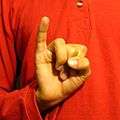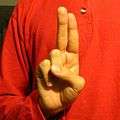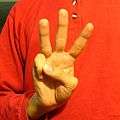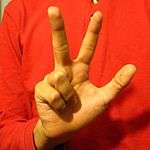American manual alphabet
The American Manual Alphabet is a manual alphabet that augments the vocabulary of American Sign Language.
Letters and digits
The letters and digits are signed as follows. In informal contexts, the handshapes are not made as distinctly as they are in formal contexts.
-

A
-

B
-

C
-

D (formal)
-

D (informal)
-

E
-

F (formal)
-

F (informal)
-

H (seen from the side)
-

I
-

J
-

K
-

L
-

M (formal)
-

M (informal)
-

N (formal)
-

N (informal)
-

O
-

P
-

Q (seen from the side)
-

R
-

S
-

T
-

U
-

V
-

W
-

X
-

Y
-

Z
-

0
-

1
-

2
-

3
-

4
-

5
-

6
-

7
-

8
-

9
The manual alphabet can be used on either hand, normally the signer's dominant hand – that is, the right hand for right-handers, the left hand for left-handers.
J and Z involve motion. J is I with a twist of the wrist, so that the little finger traces the curve of the printed form of the letter; Z is an index finger moved back and forth, so that the finger traces the zig-zag shape of the letter Z. Both of these "tracings" are made as seen by the signer if right-handed, as shown by the illustrations in this article. When signed with the left hand, the motions are in mirror image, therefore unreversed for the viewer. However, fluent signers do not need to "read" the shapes of these movements.

In most drawings or illustrations of the American Manual Alphabet, some of the letters are depicted from the side to better illustrate the desired hand shape. For example, the letters G and H are frequently shown from the side to illustrate the position of the fingers. However, they are signed with the hand in an ergonomically neutral position, palm facing to the side and fingers pointing forward.
Several letters have the same hand shape, and are distinguished by orientation. These are "h" and "u", "k" and "p" (thumb on the middle finger), "g" and "q" and, in informal contexts, "d" and "g/q". In rapid signing, "n" is distinguished from "h/u" by orientation. The letters "a" and "s" have the same orientation, and are very similar in form. The thumb is on the side of the fist in the letter "a", and in front for "s".
Rhythm, speed & movement
When fingerspelling, the hand is at shoulder height. It does not bounce with each letter unless a letter appears twice in a row. Letters are signed at a constant speed; a pause functions as a word divider. The first letter may be held for the length of a letter extra as a cue that the signer is about to start fingerspelling.
External links
- Practice fingerspelling receptive in real life Practice "reading" fingerspelling using real life videos.
- Fingerspell A free, online practice site with realistic, animated ASL fingerspelling.
- ASL Fingerspelling Resource Site Free online fingerspelling lessons, quizzes, and activities.
- ASL Fingerspelling Online Advanced Practice Tool Test and improve your receptive fingerspelling skills using this free online resource.
- Fingerspelling Beginner's Learning Tool Learn the basic handshapes of the fingerspelled alphabet.
- Manual Alphabet and Fingerspelling Further information, fingerspelling Tips and video example of ASL Alphabet.